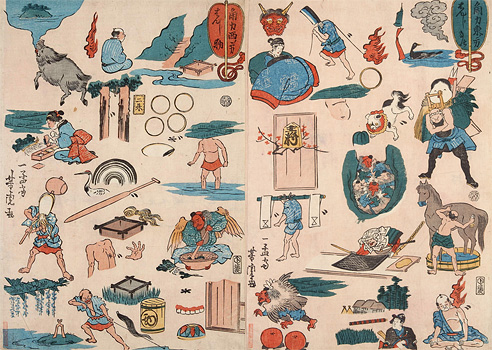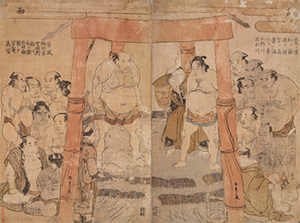Great-Edo Entertainment
Kabuki Special / Grand Sumo Special / Rakugo Special"Sumo is an occupation that requires only twenty days of annual work"
(Sumō Higashi no Kata Hanjimono, Sumō Nishi no Kata Hanjimono)
Painted by Utagawa Yoshitora 1859 (Ansei 6)
The beginning of the kanjin ōzumō tournament meant the birth of professional sumō wrestlers who could support themselves by the income from wrestling at the tournaments. Popular wrestlers soon found patrons among daimyos (feudal lords) who supported sumō and directly hired their favorite wrestlers. On a sumō ranking published during the Edo period, wrestlers were listed normally with the name of their birthplace, but you will also find those hired by the daimyos being listed with the name of the feudal domain to which they belonged. These wrestlers undertook an additional role of raising the reputation of their domain through their winning bouts.
Painted by Katsukawa Shunshō
[1782-1783]
Among the known daimyo patrons of the sumō wrestlers were the Kurume Domain (present day Fukuoka Prefecture) who supported Onogawa Kisaburō, the Matsue Domain (present day Shimane Prefecture) who backed-up Raiden Tameemon and Inazuma Raigorō, and the Kumamoto Domain (present day Kumamoto Prefecture) whose vassals included the Yoshidatsukasa family, who had a role of issuing the title of Yokozuna customarily as head of the sum referees (gyōji).
"Sumō is an occupation that requires only twenty days of annual work" is a verse (senryū) from the Edo period, describing the life of a sumō wrestler back then. The verse is saying that the wrestlers had only twenty tournament days a year, as the tournament period extended from eight days to ten days after 1778 (Anei 7), and there were only two tournaments held regularly in Edo in a year, once in spring and once in fall. The reality, however, was not so easy as it seems as the wrestlers had to go on local exhibition tours and do other odd jobs for their sponsoring domain in addition to the twenty days of the regular tournaments.
* To view more explanation, please click the each image.




